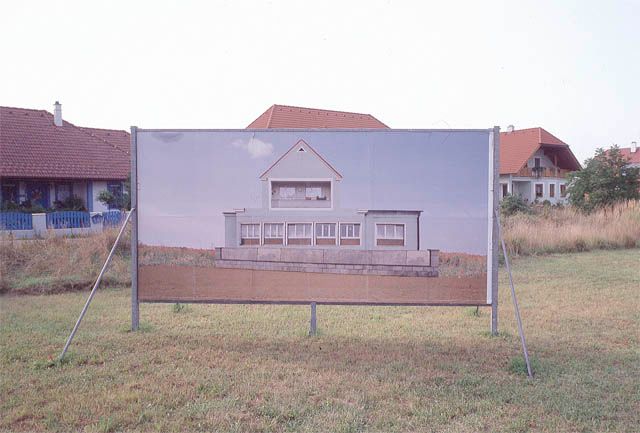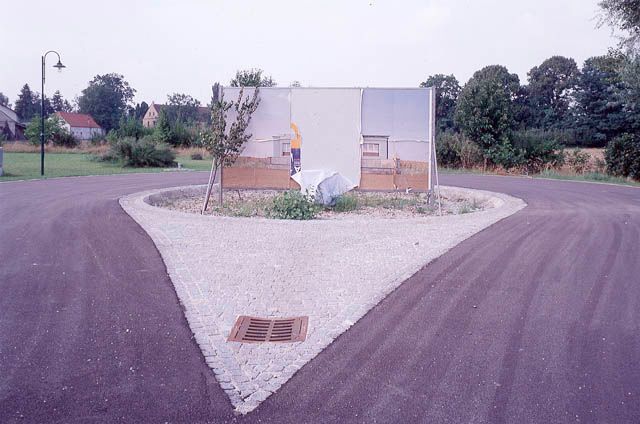Second Round
BackArtists
- With
Information
The artists Mona Hahn, Ruth Kaaserer, Richard Künz, David Moises, Werner Reiterer and Almut Rink were invited to take part in a temporary art project in Etsdorf-Haitzendorf. Their work was to be on view throughout the area one whole summer. Already the previous year a similar project had taken place in the same place. Here it became very clear that public art in the province is more fraught with problems and frictions than in the city. That art has ist place today mainly in the urban setting should not mean that it is completely out of place in the country. The wide range of activities that have been promoted for about ten years in the province of Lower Austria, and in particular in the small towns and even smaller communities, show that the opposite is true. All the same, there remains the opposition of town vs. countryside for art and the artists. One of the main reasons is related to the 'other', namely the public, and this is a purely numerical one. While contemporary art is a monority issue here and there, seen in absolute figures the group of persons interested in it, in Vienna, Linz or Graz, is still a considerable size comapared to the group of art aficionados that might be based in a small community.
In a collaborative project, Ruth Kaaserer and Almut Rink revive the cinema in Haitzendorf. The programme contains children's films, a short film programme and a documentary. A corporate identity was developed for the cinema with advertising infrastructure: a light box on the outside of the cinema marked the place, posters on information boards and in shops and pubs throughout the whole community announced the film programme.
Contributors
- Kuration
Contributions
Ruth Kaaserer
"In Watte"(In Cotton-wool)
The cousins Maria and Birgit are youths living in Etsdorf. In front of and behind the camera they convey parts of their everyday lives and their relationship with the place they live. Both spent a great deal of time in the town, where they went to school and met their friends. In Etsdorf it was primarily their families who were important, giving them security. This contrasted with uncertainty about what the future and adulthood would bring.
Almut Rink
"Sollzeit" (Should-Be Time)
The video followed the everyday path of a local resident, where work as a seamstress played a central role. The scenes alternated between showing a sober chronological recording of a day and a subjective view, focusing on individual stages of work. Everyday routine and especially special occasions like company outing and jubilees are show, everyday working life between what it should be and what it is.
Mona Hahn
"Ring der Kosmonauten"(The Cosmonaut's Ring)
The change of systems in the former-communist or socialist countries quickly found its language in the outdoor space of rural areas with western building suppliers' prefabricated elements. The posters showed a single-family house in the former Teichsiedlung (which was renamed 'Ring der Kosmonauten' for the duration of the exhibition), where individual building elements were replaced by typical design elements in the GDR from Halle-Neustadt. "Überholen ohne Einzuholen" (overtaking without catching up), two large format posters (one motif), location: Sittendorf Teichsiedlung and at Etsdorf Sportplatz.
Richard Künz
"Kunstgarten" (Art-Garden)
A group of purchased art/kitsch figures made of plastic, as found at various building suppliers' store as garden decoration, reflect the approaches to life, attitudes, in brief the way of life that is connected to the purchase and domestic display of such objects. Kunstgarten – a garden for art or art for the garden? What for – as the thing itself, as the essential, as beautification, as ornamentation? Kunstgarten – as an expression of one's own notion of art, as the expression of a cultural awareness, a grand way of reading, as an act of despair or a blunder? Kunstgarten – a prototype, mental stimulation, added precision.
David Moises
"Hollywoodhäuschen" (Rocking House)
"Ein schaukelndes Gartenhaus, ein Gartenhaus der Schaukel" (a rocking garden house, a garden house for the swing). The action is inspired by low-budget luxury, by a non-stop camper spirit. The plot is the holiday liaison between the rocking sedan and the garden house: a soft earthquake simulator with weekend flair. No, nobody is supposed to be rocked here. Local radio in Dolby surround-sound: toned cosiness in the mobile real-estate – a popular mechanism with DIY touch. Special effect: the extra soft doubled platform and other sensual contradictions.
Werner Reiterer
"Singendes Vogelhaus" (Singing Birdhouse)
The song of a bird is stored on a memory chip. This chip was powered by solar cells situated on top of the birdhouse. When the sun came out the birdhouse began singing, going quiet when night fell. The volume of the singing was coordinated with the natural bird twittering. The recording was repeated about every 20 seconds. The acoustic and temporal demarcation of a communicative place such as a plot of green with density added by an acoustic body, like the bird song's, suggests a vital and pleasant atmosphere. In addition it shows that communication is also always spread because of misunderstandings. Birds that respond to what they think is the song of one of their own species labour under their own mistake just as those people do who perceive the 'bird song' as actually authentic.


